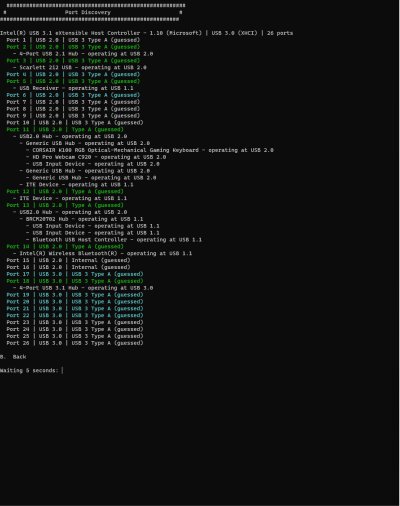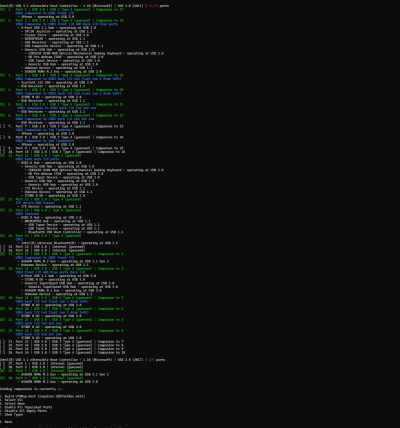- Joined
- Apr 30, 2020
- Messages
- 126
- Motherboard
- Asus ProArt Z690 Creator WiFi
- CPU
- i7-12700K
- Graphics
- RX 5700 XT
- Mobile Phone
Hello everyone, squeezing the best of the end of my holidays, I've decided to create a proper USB map for my build (there are only 2 things that are slightly problematic with this otherwise perfect build).
As I have a functioning Windows installation on a separate drive I decided to map the ports under Windows with USBtoolbox. The port discovery worked well with 2 USB A devices (one being 2.0 and another being 3.0) and 1 USBC device 3.2, No Thunderbolt device available for now.
I have attached 2 pictures for better understanding, but I'm double guessing their clarity, if they are indeed obscure, please let me know
The detection showed a lot of unidentified USB ports (#1, #7, #8, #9, #10, #15, #16, #23, #24, #25, #26) these ports are not lit up by any device I could plug. I could imagine that #15 and #16 are respective companions of #14 and #17, but it's only a wild guess. The other 9 ports are a mystery. Should I neglect them and pretend they don't exist ?
The ports I labelled 13 and 14 are 2 thunderbolt 3 ports in the back i/o that i tested with a USBc 3.2 device. Oddly they show up as #3 and #4, where as #3 and #4 are already USB 2 companions of the ports labelled 19 and 20. Is that normal ? (note : USBC on this board is exclusively with Switch).
Sorry if my questions are a bit "simple" but it's my first proper USB mapping and I want to do it extra well by the rules.
Also, if this post should go into the USB mapping thread, please excuse me and feel free to move it (I didn't want to crowed a thread already bulky).
Cheers!
EDIT : Now I think about it, could these "ghost" ports be the (far to many) Led headers ?
As I have a functioning Windows installation on a separate drive I decided to map the ports under Windows with USBtoolbox. The port discovery worked well with 2 USB A devices (one being 2.0 and another being 3.0) and 1 USBC device 3.2, No Thunderbolt device available for now.
I have attached 2 pictures for better understanding, but I'm double guessing their clarity, if they are indeed obscure, please let me know
The detection showed a lot of unidentified USB ports (#1, #7, #8, #9, #10, #15, #16, #23, #24, #25, #26) these ports are not lit up by any device I could plug. I could imagine that #15 and #16 are respective companions of #14 and #17, but it's only a wild guess. The other 9 ports are a mystery. Should I neglect them and pretend they don't exist ?
The ports I labelled 13 and 14 are 2 thunderbolt 3 ports in the back i/o that i tested with a USBc 3.2 device. Oddly they show up as #3 and #4, where as #3 and #4 are already USB 2 companions of the ports labelled 19 and 20. Is that normal ? (note : USBC on this board is exclusively with Switch).
Sorry if my questions are a bit "simple" but it's my first proper USB mapping and I want to do it extra well by the rules.
Also, if this post should go into the USB mapping thread, please excuse me and feel free to move it (I didn't want to crowed a thread already bulky).
Cheers!
EDIT : Now I think about it, could these "ghost" ports be the (far to many) Led headers ?
Attachments
Last edited:



